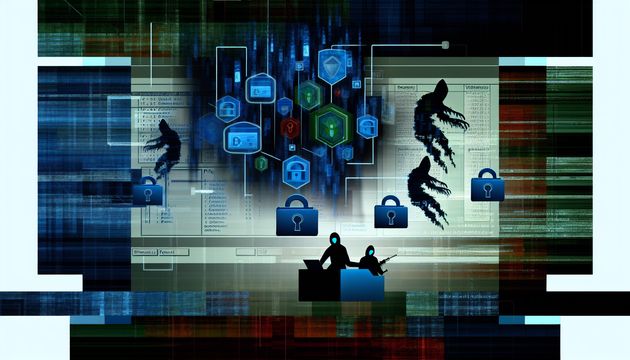
Enhancing GitLab's Security: Addressing Vulnerabilities and Strengthening Defenses
GitLab, a leader in the DevSecOps space, has recently tackled several high-severity vulnerabilities that could have allowed attackers to take over user accounts and inject malicious jobs into CI/CD pipelines. These vulnerabilities, identified under CVEs such as CVE-2025-4278 and CVE-2025-5121, highlight the ongoing challenges in securing complex software environments. The potential for account takeovers and unauthorized actions underscores the critical need for robust security measures. GitLab’s proactive approach in releasing patches and urging users to update to the latest versions demonstrates its commitment to safeguarding user data and maintaining platform integrity.
GitLab’s Security Vulnerabilities and Mitigation Measures
Recent Vulnerabilities and Their Impact
GitLab, a prominent DevSecOps platform, has been addressing several high-severity vulnerabilities that could potentially allow attackers to take over accounts, inject malicious jobs, and exploit other security weaknesses. These vulnerabilities have been identified and tracked under various CVEs, including CVE-2025-4278, CVE-2025-5121, CVE-2025-2254, and CVE-2025-0673. Each of these vulnerabilities poses unique threats to GitLab users and their data.
HTML Injection and Account Takeover
The HTML injection vulnerability, tracked as CVE-2025-4278, allows remote attackers to inject malicious code into GitLab’s search page. This could lead to account takeovers, enabling attackers to gain unauthorized access to user accounts. Imagine it like someone sneaking into your house through an open window—once inside, they can do anything you could do. The severity of this vulnerability is heightened by the potential for attackers to execute arbitrary code, thereby compromising the integrity of user data and operations.
Missing Authorization and CI/CD Pipeline Injection
The missing authorization issue, identified as CVE-2025-5121, affects GitLab Ultimate EE. This vulnerability allows remote threat actors to inject malicious CI/CD jobs into any project’s future pipelines. Although exploitation requires authenticated access to GitLab instances with a GitLab Ultimate license, the potential for malicious actors to disrupt CI/CD processes poses significant risks to software development and deployment. Think of it as someone sneaking into a factory and tampering with the assembly line—everything that comes out could be compromised.
Cross-Site Scripting (XSS) and Denial of Service (DoS)
GitLab has also addressed a cross-site scripting vulnerability, CVE-2025-2254, which could enable attackers to act in the context of a legitimate user. This could lead to unauthorized actions being performed on behalf of the user, compromising the security of their account and data. Additionally, a denial of service flaw, CVE-2025-0673, was identified, which can trigger infinite redirect loops, causing memory exhaustion and denying access to legitimate users.
Mitigation Measures and Security Patches
GitLab has been proactive in releasing security patches to address these vulnerabilities. The company has urged all users to upgrade to the latest versions to mitigate these risks effectively.
Recommended Updates and Versions
GitLab has released security updates for both its Community and Enterprise Editions. The recommended versions for mitigating the identified vulnerabilities include 18.0.2, 17.11.4, and 17.10.8 (BleepingComputer). These updates contain critical bug and security fixes, and GitLab has strongly recommended that all self-managed installations be upgraded immediately.
Addressing Critical Flaws
In addition to the aforementioned vulnerabilities, GitLab has also patched critical flaws tracked as CVE-2025-25291 and CVE-2025-25292. These vulnerabilities impact GitLab’s ruby-saml component and could lead to authentication bypass if exploited (SecPod Blog). The CVSS score for these vulnerabilities is 8.8, indicating their high severity.
Continuous Monitoring and Response
GitLab’s approach to security involves continuous monitoring and rapid response to emerging threats. The company has emphasized the importance of maintaining up-to-date installations to protect against potential exploits. GitLab Dedicated customers have been assured that their instances are already running the patched versions, reducing the risk of exposure to these vulnerabilities (BleepingComputer).
Historical Context and Vulnerability Trends
Analyzing the historical context of GitLab’s security vulnerabilities provides insights into the evolving threat landscape and the company’s response strategies.
Vulnerability Statistics Over the Years
A review of GitLab’s vulnerability statistics reveals a fluctuating trend in the number of identified vulnerabilities over the years. For instance, in 2025, nine vulnerabilities were recorded with an average CVSS score of 5.56. In contrast, 2024 saw a higher number of vulnerabilities, with 138 identified and an average score of 6.32 (Stack Watch). These statistics highlight the ongoing challenges in maintaining security within complex software environments.
Notable Breaches and Lessons Learned
GitLab repositories have been targeted in attacks due to the sensitive information they contain. Notable breaches, such as those experienced by Europcar Mobility Group and Pearson, underscore the importance of robust security measures (BleepingComputer). These incidents have prompted GitLab to enhance its security protocols and encourage users to adopt best practices for safeguarding their repositories.
User Recommendations and Best Practices
To further mitigate the risks associated with these vulnerabilities, GitLab users are encouraged to adopt several best practices.
Regular Updates and Patch Management
Ensuring that GitLab installations are regularly updated with the latest security patches is crucial for minimizing exposure to vulnerabilities. Users should monitor official GitLab announcements and promptly apply updates to maintain a secure environment.
Implementing Access Controls and Monitoring
Strengthening access controls and monitoring user activities can help detect and prevent unauthorized access attempts. Organizations should implement multi-factor authentication and regularly review access logs to identify potential security incidents.
Educating Users and Raising Awareness
Raising awareness among users about the importance of security practices is essential for fostering a culture of cybersecurity. Training programs and resources should be made available to educate users on identifying phishing attempts, recognizing suspicious activities, and reporting potential security threats.
Future Outlook and Security Enhancements
Looking ahead, GitLab is expected to continue enhancing its security measures to address emerging threats and vulnerabilities.
Investment in Security Research and Development
GitLab’s commitment to security includes ongoing investment in research and development to identify and mitigate potential vulnerabilities. Collaborations with security researchers and participation in bug bounty programs are likely to play a significant role in strengthening GitLab’s security posture.
Adoption of Advanced Security Technologies
The adoption of advanced security technologies, such as machine learning and artificial intelligence, can enhance GitLab’s ability to detect and respond to threats in real time. These technologies can provide valuable insights into threat patterns and enable proactive defense strategies.
In conclusion, GitLab’s efforts to address high-severity vulnerabilities and implement effective mitigation measures demonstrate its commitment to maintaining a secure platform for its users. By staying informed about the latest security updates and adopting best practices, GitLab users can significantly reduce their risk of exposure to potential threats.
Final Thoughts
GitLab’s recent efforts to patch high-severity vulnerabilities reflect its dedication to maintaining a secure platform for its users. By addressing issues such as HTML injection and missing authorization, GitLab not only protects its users but also sets a standard for security in the DevSecOps industry. The company’s continuous investment in security research and development, along with its adoption of advanced technologies like AI, positions it well to tackle future threats. Users are encouraged to stay informed about the latest updates and adopt best practices to minimize risks. For more details on these vulnerabilities and GitLab’s response, see BleepingComputer and SecPod Blog.
References
- BleepingComputer. (2025). GitLab patches high-severity account takeover, missing auth issues. https://www.bleepingcomputer.com/news/security/gitlab-patches-high-severity-account-takeover-missing-auth-issues/
- SecPod Blog. (2025). Git wrecked: GitLab users urged to patch critical security flaws. https://www.secpod.com/blog/git-wrecked-gitlab-users-urged-to-patch-critical-security-flaws/
- Stack Watch. (2025). GitLab vulnerability statistics. https://stack.watch/product/gitlab/gitlab/



